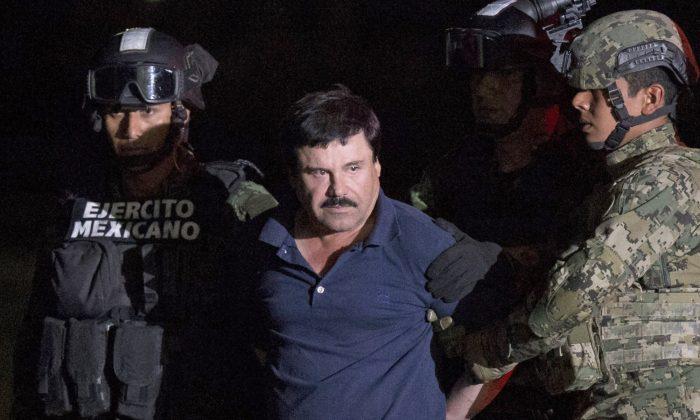MEXICO CITY— The northern Mexico prison where authorities suddenly transferred convicted drug lord Joaquin “El Chapo” Guzman is rated as the worst in the federal penitentiary system for inmate conditions and other factors, according to the government’s own reporting.
The Cefereso No. 9 facility on the outskirts of Ciudad Juarez, which borders El Paso, Texas, did score well on “conditions of governability,” perhaps an indication that authorities believe they can control Guzman’s environment there and limit the risk of him pulling off a third brazen jailbreak.
But Michael Vigil, the former head of international operations for the U.S. Drug Enforcement Administration, questioned the logic of sending Guzman to a less-secure prison that’s in territory firmly controlled by “El Chapo’s” Sinaloa cartel after it emerged victorious from a war with the Juarez cartel in recent years.
“It just doesn’t make any sense,” Vigil said Sunday. “He has that part of his empire, he has the infrastructure there and he has people who would assist him in terms of engineering him another escape.”
A 2015 report by the governmental National Human Rights Commission gave the Juarez prison an overall 6.63 rating on a scale of 0 to 10, the lowest for any of Mexico’s 21 federal prisons. By comparison, the maximum-security Altiplano facility near Mexico City where Guzman was confined before was 10th best with a rating of 7.32.
Altiplano is considered the country’s highest-security prison, and many had thought it to be unescapable. That belief was shattered in July 2015 when Guzman fled the facility through a sophisticated, mile-long tunnel that accomplices dug to the shower in his cell, complete with a motorcycle modified to run on rails laid down in the passage.

Cefereso No. 9 is located just off the Pan-American highway about 14 miles (23 kilometers) south of downtown Juarez, in the middle of the barren, scorching Chihuahuan Desert. Other than a university campus about 2 miles (3 kilometers) to the east, there’s hardly anything else for miles in any direction.
Gov. Cesar Duarte of Chihuahua, where Juarez is located, bragged about the facility’s ability to hold Guzman, saying at a news conference that the transfer posed no risk for his state and was a sign of its improvements on security matters.
“The decision to have him brought here is because there will be no escape,” Duarte told reporters. “If he was brought here from Altiplano it’s because the security conditions are way above those of Altiplano, that’s what the federal government settled on. ... So there is no risk of escape.”
The Sinaloa cartel boss, who is fighting to stave off extradition to the United States where he faces drug charges in seven different jurisdictions, was transferred to Juarez in the pre-dawn hours Saturday in a surprise, high-security operation.
Mexican authorities said the move was due to security upgrades at Altiplano and also part of a routine policy to rotate inmates for security reasons. Analysts said officials may also have wanted to shake up his confinement to thwart any escape plans that could have been in the works.
Vigil warned that Guzman should not remain in Juarez for an extended period.
“If they keep him there for a prolonged period of time, the Mexican government certainly is risking that he escapes,” Vigil said. “And if he escapes, it would just completely decimate the credibility of the Mexican government, without question.”
According to the rights commission’s report, Cefereso No. 9 got low marks for guaranteeing a “dignified” stay and for handling inmates with special requirements. It got middling scores for guaranteeing prisoners’ safety and well-being, and for rehabilitation.
It was also listed as somewhat overcrowded, with 1,012 inmates living in a facility with a designed capacity of 848. Authorities acknowledge that overcrowding is a widespread problem throughout Mexico’s penitentiary system.
Overall Cefereso No. 9 got a “yellow” evaluation for 2015 on the report’s stoplight-style rating system. That was improved from “red” in 2014, even if its numerical score was still the country’s lowest.
“Governability” was the only area where the prison received a “green,” or good, rating. Altiplano also got a “green” rating for governability conditions.
“El Chapo” first broke out of a Mexican prison in 2001 and spent more than a decade on the run as one of the world’s most-wanted fugitives. He was recaptured in 2014, only to escape the following year. Mexican marines re-arrested him in the western state of Sinaloa in January, after he fled a safe house through a storm drain.
Guzman was returned to Altiplano, where officials beefed up his security regimen. He was placed under constant observation from a ceiling camera with no blind spots, and the floors of top-security cells were reinforced with metal bars and a 16-inch (40-centimeter) layer of concrete. Prison authorities also restricted his visits.
A lawyer for Guzman confirmed Saturday that his defense continues to fight extradition, and Mexican officials have said the process could take months or up to a year to reach a final ruling.





